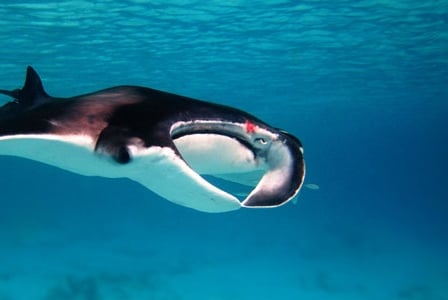
Learn why you would never want to invite a shark and a manta ray to the same dinner party (hypothetically speaking) on this Wildlife Wednesday!
In the past, manta rays were thought to be aggressive and dangerous to humans; sailors would even tell tales about mantas capsizing boats by jumping into them. The reality is that these gentle filter feeders, while powerful, don’t really have much of an interest in hopping a free ride.
Habitat
Manta rays can be found in most of the world’s tropical to temperate oceans, from the coasts of Hawaii to the coral reefs of Australia.
Trivia
- Does a rose by any other name smell as … fishy? People seem to think so, because manta rays sport an impressive list of aliases. Common ones include “blanketfish” (three guesses why), as well as “devil fish” and “sea devil” (referring to the cephalic fins on their heads).
- Divers often compare swimming underneath manta rays to being overtaken by flying saucers. And it’s no wonder why—manta rays can stretch up to nearly 30 ft (9 m) and weigh up to 3,000 lbs (1,360 kg).
- Fortunately, they’re quite a bit more peaceful than their cousin the shark; while still carnivores in the strictest sense, these flattened fish are filter feeders that snack on plankton.
- Due to their large size, manta rays have only one natural predator—the shark. (Talk about a family feud!)
Why so blue?
While manta ray population numbers aren’t known, researchers suspect that those numbers have decreased significantly—up to 80 percent in some areas—over the past 75 years, mainly due to fishing practices that either directly target the creatures or catch them as bycatch.
Luckily, many governments, including the US, the Philippines, Mexico, Brazil, and New Zealand, have laws against capturing or killing these sizable sea-dwellers. As recently as February 2014, Indonesia—once the world’s largest shark and ray fishery—created the world’s largest manta ray sanctuary, giving manta rays full protection in the waters surrounding the archipelago.

